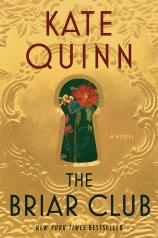The Briar Club
Review
The Briar Club
THE BRIAR CLUB, Kate Quinn’s latest novel, is set in an all-female boardinghouse in Washington, D.C., smack-dab in the middle of McCarthyism and the Red Scare.
A murder has darkened a recent anomalous blossom in the Briarwood House, dampening the chances of a community developing inside its society of isolation. Despite the conflicting backgrounds, issues and personalities of its residents, the commonality of a friendship with Grace March --- the woman living in the attic --- forms slivers of bonds within Briarwood. But while newfound connections first begin to entangle, so does old, scathing secrets. Quinn effectively personifies the Briarwood House, thanks to borrowing the “If these walls could talk…” adage to highlight the brooding pasts and uncertain futures of its inhabitants. Readers are treated to an intricate web of ambition, malevolence, love and paranoia.
"All chapters in THE BRIAR CLUB are prefaced by which characters’ perspective the third-person narration will focus on. Readers who love the 'history' portion of the historical fiction genre will appreciate the sociopolitical roles the characters play."
One thing that all of Grace’s new friends have in common is how recipes from their lives and families shed light on their pasts. Throughout the book, Quinn writes these recipes like pages in a recipe book. Nora, for example, is caught in a dangerous love affair, to which Quinn uses a recipe to illustrate how smitten that she --- the daughter of a police officer --- had become with a local mob man. The ingredients and first two steps of “Xavier’s Corned Beef Hash” all check out for a basic recipe, but Step Three is where things get spicy: “Enjoy in bed with a lover, with plenty of extra napkins, while listening to ‘Goodnight, Irene’ by Gordon Jenkins and The Weavers.”
It isn’t long before Nora first asserts her independence over her conniving brother and mother, after being prefaced by her very own colcannon recipe. The final step advises: “Enjoy alone on a bad day, with nips of Jameson, while listening to ‘If’ by Perry Como,” right before she finally stands up to her corrupt, money-grubbing brother and their enabling mother. Before the 150th page, Quinn has showcased a unique way to develop her characters, while simultaneously deviating from the narration stream in a refreshing way.
Another conflicted Briarwood resident is Bea, a former baseball player, who yearns for the rush and purposefulness of her athletic glory days during World War II. Just before a political argument at a Briarwood barbecue, Quinn drops Bea’s Ragù recipe. The final step reads: “Top with plenty of grated pecorino and eat on a summer day, in between bouts of singing the All-American Girls Professional Baseball League ‘Victory Song.’” Bea offers a pickup baseball game to vent frustrations when the barbecue’s tensions get too high, with Grace’s “beau,” J.D., defending the female Russian soldiers he battled alongside from the xenophobia of Bea’s new lover, Harland. This leads to a more constructive day than arguing at a barbecue, and Bea is even asked to show a few pointers by some of their game’s players.
By this point, readers are keen on Quinn’s recipe technique as they know some development and/or contextualization is imminent. In Bea’s case, her Ragù recipe signals that her athletic life, which she has always hoped would somehow return, has finally manifested a positive presence in her life. Instead of mourning a lost paradise of the past, she uses her memories of the Victory Song to solve a present problem and reaps the benefits.
All chapters in THE BRIAR CLUB are prefaced by which characters’ perspective the third-person narration will focus on. Readers who love the “history” portion of the historical fiction genre will appreciate the sociopolitical roles the characters play. Fliss, a housewife and mother who parades around like her life perfectly fulfills her, and Arlene, a bigger xenophobe than Harland, fit historical roles that history buffs can piece together in Quinn’s 1950s puzzle.
Fans of character-driven stories also will be satisfied with the characters and arcs that Quinn has crafted. While they seem to fit historical roles, she still develops them thoughtfully, ensuring that her book is about people and not types of people discussed in history textbooks. The best way she accomplishes this is through her recipe technique. It genuinely would be difficult to avoid copying down at least one recipe from her robust novel.
Reviewed by Sam Johnson on July 26, 2024
The Briar Club
- Publication Date: July 8, 2025
- Genres: Fiction, Historical Fiction, Women's Fiction
- Paperback: 432 pages
- Publisher: William Morrow Paperbacks
- ISBN-10: 0063244756
- ISBN-13: 9780063244757




